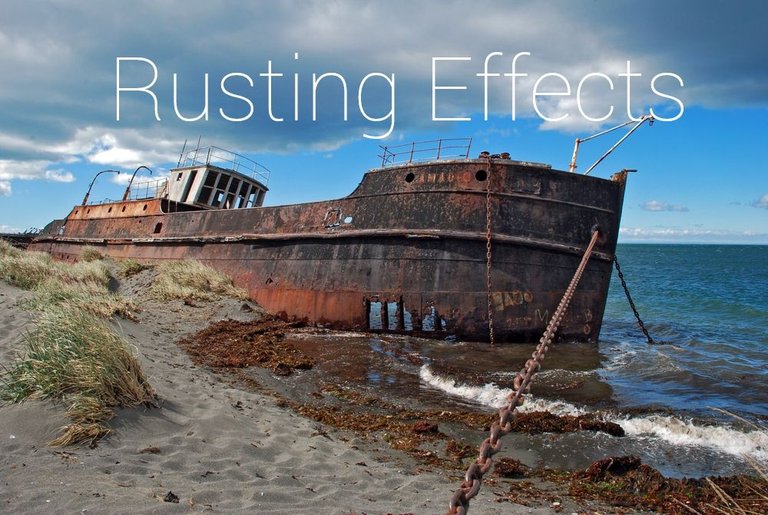Rusting of Iron & Its Effects, Conditions Necessary for Rusting To Occur
Rusting is caused by reactions of moisture (water) and air(oxygen) which are the basic elements which make most iron materials to undergo rusting. Aside oxygen and water, there are other compounds such as acids and salt which also react with the metal surfaces and cause rusting.

The process of rusting....
This happens as a natural phenomenon when the above elements or compounds come into contact with iron( oxygen, water, acid and salt). What we have to remember is that, the most common ones are the oxygen and moisture coming into contact with the iron substance. The process occur as as chemical reaction known as iron oxidation to for hydrated iron, that's the reaction of both oxygen and moisture to form reddish brown colour.
The equation for Hydrated iron:
4Fe + 3O2 → 2Fe2O3.
4Fe + 3O2 + 2nH2O--->2Fe2O3•2nH2O
Moisture and oxygen is always in circulation in the atmosphere. If the iron materials are not coated with any other iron resistant materials like alloy and zinc, they easily become exposed to moisture from daily raindrops or precipitation and oxygen blowing around. As time goes on, it would get to a point where the reaction will turn into reddish brown. It's really difficult for a compound to reverse when formed. That is basically one of the properties of a compound. But,a mixture isn't like that since it can be separated by physical means.
1• Water/Moisture: Rusting needs the presence of water or moisture. When iron is exposed to water , the water molecules combine with carbon dioxide from the atmosphere to form a weak acid known as carbonic acid. This acid reacts or combine with iron, forming the rusting process.
2• Oxygen: Oxygen is another important conditions which enable rusting to occur. It reacts with iron atoms on the metal's surface, leading to the creation of iron oxide or rust. This reaction is speed up in the presence of both moisture and oxygen. Hence both moisture and atmospheric oxygen are said to be catalyst for the rusting to occur.
3• Salt and acidic substances: Rusting can be further occur in the presence of salts or acids. Both salt and acids are also great components in the formation of corrosion( rusting occuring in all metallic substances). This increases the process of rusting.
Effects of rusting:
1• Weakening of metal structures: Rust can compromise the structural integrity of iron-based objects like bridges, buildings, or pipelines. As the iron oxidizes, it expands, causing cracks and fractures in the material. This can ultimately lead to the collapse or failure of the affected structure. It's therefore obvious to see most bridges and railways lines made with iron rusting and wearing off.
2• Deterioration of appearance and the lustre of most iron: Rust stains and discolors iron, diminishing its aesthetic appeal. When iron materials are first bought from a shop, they look very beautiful and attractive, but as they are exposed to rusting, they immediately lose their lustre. It can make objects appear old, worn out, and unkempt. This is particularly problematic for decorative ironwork, sculptures, or outdoor furniture.
3• Impaired functionality: Rusting can impair the functionality of iron-based tools, machinery, or equipment. The formation of rust can hinder moving parts, leading to friction, jamming, or even complete failure of the affected components. For instance, bolts and knots which are made of irons normally rust and we find it very difficult to remove them.
4• Health and safety risks: In certain cases, rusting can pose health and safety risks. When iron rusts, it often flakes off, creating sharp edges that can cause injuries if handled without caution. Moreover, corroded iron in water pipes or storage tanks can contaminate drinking water, posing potential health hazards. It's a serious poisons when we drink water from rusted iron pipes. Most of them are similar to lead poison as corrosion occurs.
Prevention and control measures:
To prevent rusting, various protective measures can be employed, including:
1• Coating: Applying protective coatings such as paint, varnish, or specialized rust-resistant coatings can act as a barrier between iron and moisture, reducing the chances of rust formation.
2• Galvanization: Galvanizing involves coating iron or steel with a layer of zinc, which provides sacrificial protection. The zinc layer corrodes more readily than iron, thus protecting the underlying metal.
3• Proper maintenance: Regular cleaning, drying, and lubrication of iron-based objects can help prevent the accumulation of moisture and slow down the corrosion process.
4• Humidity control: Reducing humidity levels in the surrounding environment can limit the moisture available for rusting. Using dehumidifiers or ensuring adequate ventilation can be effective in minimizing rust formation.
By understanding the causes, effects, and preventive measures associated with rusting, individuals and industries can take appropriate steps to mitigate its impact and maintain the longevity and functionality of iron-based materials.
I think the rate at which materials are exposed to rusting has greatly reduced these periods. Most firms uses galvanized iron to make anything they want to do now making it difficult for rust to take place. Rusting will soon be put under control very soon as the people are enlightened about the effective process of preventing iron from rusting. Thank you ☺️☺️☺️
That's really true. For the introduction of galvanization, it has really helped a lot!
Yeah
Thanks for your contribution to the STEMsocial community. Feel free to join us on discord to get to know the rest of us!
Please consider delegating to the @stemsocial account (85% of the curation rewards are returned).
You may also include @stemsocial as a beneficiary of the rewards of this post to get a stronger support.